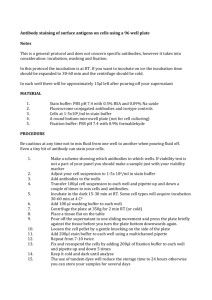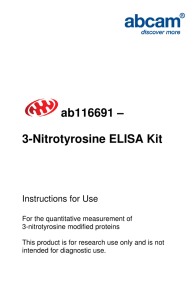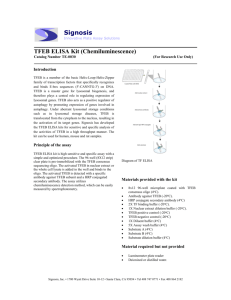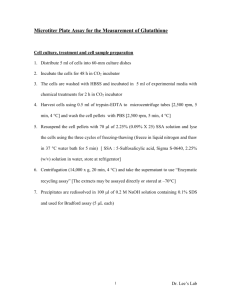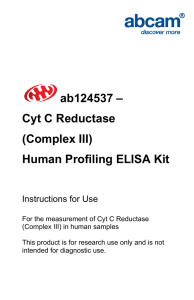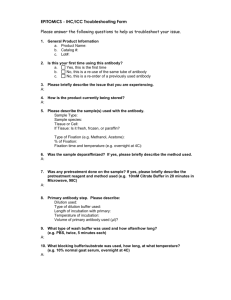ab129734 – ACADM ELISA kit Instructions for Use
advertisement
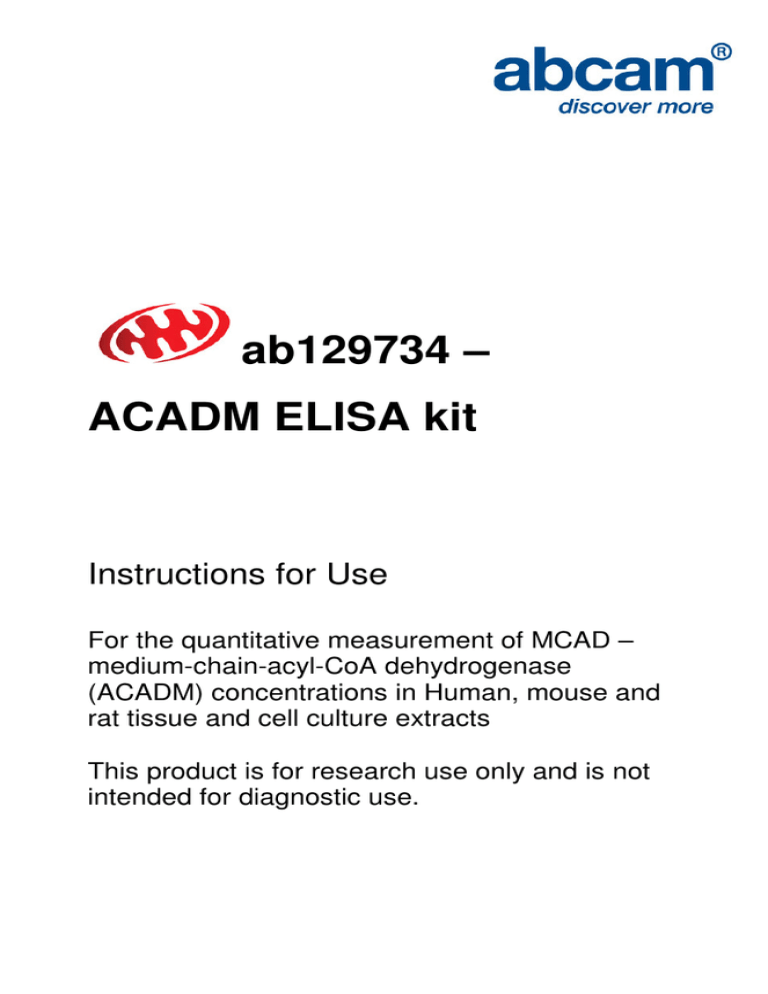
ab129734 – ACADM ELISA kit Instructions for Use For the quantitative measurement of MCAD – medium-chain-acyl-CoA dehydrogenase (ACADM) concentrations in Human, mouse and rat tissue and cell culture extracts This product is for research use only and is not intended for diagnostic use. 1 Table of Contents 1. Introduction 3 2. Assay Summary 5 3. Kit Contents 6 4. Storage and Handling 6 5. Additional Materials Required 7 6. Preparation of Reagents 8 7. Sample Preparation 9 8. Assay Procedure 11 9. Data Analysis 14 10. Specificity 17 11. Troubleshooting 18 2 1. Introduction Principle: ab129734 Medium-chain-acyl-CoA dehydrogenase (MCAD, gene ACADM) ELISA (Enzyme-Linked Immunosorbent Assay) kit is an in vitro enzyme-linked immunosorbent assay for the accurate quantitative measurement of medium-chain-acyl-CoA dehydrogenase in Human, rat and mouse tissue and cell culture extracts. The assay employs an ACADM specific antibody coated onto well plate strips. Standards and samples are pipetted into the wells and ACADM present in the sample is bound to the wells by the immobilized antibody. The wells are washed and a primary antiACADM detector antibody is added. After washing away unbound primary detector antibody, biotin affinity HRP-conjugated streptavidin is pipetted into the wells. The wells are again washed, a TMB substrate solution is added to the wells and color develops in proportion to the amount of ACADM bound. The developing blue color is measured at 600 nm. Optionally the reaction can be stopped by adding hydrochloric acid which changes the color from blue to yellow and the intensity can be measured at 450 nm. 3 Background: MCAD (medium-chain acyl-CoA dehydrogenase), encoded by the ACADM gene, is an oxidoreductase enzyme of the mitochondrial fatty acid beta-oxidation pathway that is specific for acyl chain lengths of 4 to 16. MCAD utilizes the electron transfer flavoprotein (ETF) as an electron acceptor that transfers the electrons to the main mitochondrial respiratory chain via ETF-ubiquinone oxidoreductase (ETF dehydrogenase). Defects in ACADM are the cause of medium-chain acyl-CoA dehydrogenase deficiency (MCAD deficiency) [MIM:201450], an autosomal recessive disease which causes fasting hypoglycemia, hepatic dysfunction, and encephalopathy, often resulting in death in infancy. MCAD deficiency is one of the most common inherited disorders of metabolism (1:15000). Many mutations have been identified causing MCAD deficiency, however 90% of cases are a result of the common mutation is Lys 304 Glu (K304E) which alters the enzymes activity and stability, see section 10. Specificity below. 4 2. Assay Summary Equilibrate all reagents to room temperature. Prepare all the reagents, samples, and standards as instructed. Add 50 µL standard or sample to each well used. Incubate 2 hours at room temperature. Aspirate and wash each well three times. Add 50 µL prepared primary detector antibody to each well. Incubate 1 hour at room temperature. Aspirate and wash each well three times. Add 50 µL prepared HRP labeled secondary detector antibody. Incubate 1 hour at room temperature. Aspirate and wash each well three times. Add 100 µL TMB Development Solution to each well. Immediately begin recording the color development with elapsed time at 600 nm for 15 minutes. Alternatively add a Stop solution at a user-defined time and read at 450 nm. 5 3. Kit Contents Item Quantity 20X Buffer 20 mL Extraction Buffer 15 mL 10X Blocking Buffer 6 mL TMB Development Solution 12 mL 10X ACADM Detector Antibody 1 mL 10X HRP Label 1 mL ACADM Standard (1 µg) 1 vial ACADM Microplate (12 x 8 antibody coated well strips) 96 Wells 4. Storage and Handling Store all components at 4°C. This kit is stable for 6 months from receipt. After reconstitution the standard should be aliquoted and stored at -80°C. Unused microplate strips should be returned to the pouch containing the desiccant and resealed. 6 5. Additional Materials Required • Microplate reader capable of measuring absorbance at 600 nm (or 450 nm after addition of Stop solution - not supplied.) • Method for determining protein concentration (BCA assay recommended). • Deionized water • Multi and single channel pipettes • PBS (1.4 mM KH2PO4, 8 mM Na2HPO4, 140 mM NaCl, 2.7 mM KCl, pH 7.3) • Tubes for standard dilution • Stop solution (optional) – 1N hydrochloric acid • Optional plate shaker for all incubation steps • Well plate cover or seals 7 6. Preparation of Reagents 6.1 Equilibrate all reagents and samples to room temperature (18-25°C) prior to use. 6.2 Prepare 1X Wash Buffer by adding 20 mL 20X Buffer to 380 mL nanopure water. 6.3 Prepare 1X Incubation Buffer by adding 6 mL 10X Blocking Buffer to 54 mL 1X Wash Buffer. Excess unused 1X Incubation buffer may be stored at -20°C for 6 months after performing the ELISA. 6.4 Prepare the primary 1X ACADM Detector Antibody by diluting the 10X ACADM Detector Antibody 10-fold with 1X Incubation Buffer immediately prior to use. Prepare 0.5 mL for each 8 well strip used. 6.5 Prepare the 1X HRP Label by dilution the 10X HRP Label 10-fold with 1X Incubation Buffer immediately prior to use. Prepare 0.5 mL for each 8 well strip used. 6.6 Reconstitute the 1 µg standard by adding 200 µL of nanopure water and vortex vigorously; the final concentration will be 5 µg/mL. Allow to sit for 10 minutes on ice and repeat vortex. Aliquot and freeze spare tubes at -80°C 6.7 To prepare serially diluted standards, first label tubes #1-7. Add 150 µL of 1X Incubation Buffer to each of tubes #2 through #7. 8 6.8 Prepare the standard curve sample (tube tube #1) at 1000 ng/mL by diluting 100 uL of the 5 µg/mL reconstituted protein in 400 µL of 1X Incubation buffer. Transfer 150 µL µ from tube #1 to tube #2. Mix thoroughly. With a fresh pipette tip transfer 150 µL L from #2 to #3. Mix thoroughly. Repeat for Tubes #4 through #7. 6.9 Use 1X Incubation buffer as the zero standard tube labeled #8. Use fresh standards for each assay. 7. Sample Preparation Note: The extraction buffer provided with this kit should only be used with mammalian expression systems. This buffer can be supplemented with phosphatase inhibitors, PMSF and protease inhibitorr cocktail prior to use. Supplements should be used according to manufacturer’s instructions. 7.1 Preparation of extract from cell pellets. 9 7.1.1 Collect non adherent cells by centrifugation or scrape to collect adherent cells from the culture flask. Typical centrifugation conditions for cells are 500 x g for 10 min at 4°C. 7.1.2 Rinse cells twice with PBS. 7.1.3 Solubilize cell pellet at 2x10 /mL in Extraction Buffer. 7.1.4 Incubate on ice for 20 minutes. Centrifuge at 16,000 x g, 4°C for 20 minutes. Transfer the 7 supernatants into clean tubes and discard the pellets. Assay samples immediately or aliquot and store at -80°C. The sample protein concentration in the extract may be quantified using a protein assay. 7.2 Preparation of extracts from tissue homogenates. 7.2.1 Tissue lysates are typically prepared by homogenization of tissue that is first minced and thoroughly rinsed in PBS to remove blood (dounce homogenizer recommended). 7.2.2 Suspend the homogenate to 10 mg/mL in PBS. 7.2.3 Solubilize the homogenate by adding equal volume of Extraction Buffer to the homogenate. 7.2.4 Incubate on ice for 20 minutes. Centrifuge at 16,000 x g, for 20 minutes at 4°C. Transfer the supernatants into clean tubes and discard the pellets. Assay samples immediately or aliquot and 10 store at -80°C. The sample protein concentration in the extract may be quantified using a protein assay. The sample should be diluted to within the working range of the assay in 1X Incubation Buffer. As a guide, typical ranges of sample concentration for commonly used sample types are shown below in Data Analysis. 8. Assay Procedure Equilibrate all reagents to room temperature prior to use. It is recommended all samples and standards be assayed in duplicate. 8.1 Prepare all reagents, working standards, and samples as directed in the previous sections. 8.2 Remove unused microplate strips from the plate frame, return them to the foil pouch containing the desiccant pack, and reseal. 8.3 Add 50 µL of each serially diluted ACADM protein standard or test sample per well. Also include a 1X Incubation buffer as a zero standard. 8.4 The samples should be diluted to within the working range of the assay in 1X Incubation Buffer. As a guide, typical ranges of sample concentration and assay tolerance for 11 commonly used sample buffers are shown below in Data Analysis. 8.5 Cover/seal the plate and incubate for 2 hours at room temperature. If available use a plate shaker for all incubation steps at 300 rpm. 8.6 Aspirate each well and wash, repeat this twice more for a total of three washes. Wash by aspirating or decanting from wells then dispensing 300 µL 1X Wash Buffer into each well as described above. Complete removal of liquid at each step is essential to good performance. After the last wash, remove the remaining buffer by aspiration or decanting. Invert the plate and blot it against clean paper towels to remove excess liquid. 8.7 Immediately prior to use prepare sufficient (0.5 mL/8 well strip used) 1X ACADM Detector Antibody (step 6.4) in 1X Incubation Buffer. Add 50 µL 1X ACADM Detector Antibody to each well used. Cover/seal the plate and incubate for 1 hour at room temperature. If available use a plate shaker for all incubation steps at 300 rpm. 8.8 Repeat the aspirate/wash procedure above. 8.9 Immediately before use, prepare sufficient (0.5 mL/8 well strip used) 1X HRP Labeled (step 6.5) in 1X Incubation Buffer. Add 50 µL 1X HRP Labeled to each well used. Cover/seal the plate and incubate for 1 hour at room 12 temperature. If available use a plate shaker for all incubation steps at 300 rpm. 8.10 Repeat the aspirate/wash procedure above. 8.11 Add 100 µL TMB Development Solution to each empty well and immediately record the blue color development with time in the microplate reader prepared with the following settings: Mode: Kinetic Wavelength: 600 nM Time: up to 15 min. Interval: 20 sec. - 1 min. Shaking: Shake between readings Alternative– In place of a kinetic reading, at a user defined time record the endpoint OD data at (i) 600 nm or (ii) stop the reaction by adding 100 µL stop solution (1N HCl) to each well and record the OD at 450 nm. Analyze the data as described below. 13 9. Data Analysis Average the duplicate standard readings and plot against their concentrations after subtracting the zero standard reading. Draw the best smooth curve through these points to construct a standard curve. Most plate reader software or graphing software can plot these values and curve fit. A four parameter algorithm (4PL) usually provides the best fit, though other equations can be examined to see which provides the most accurate (e.g. linear, semi-log, log/log, 4-parameter logistic). Extrapolate ACADM protein concentrations for unknown and control samples from the standard curve plotted. Samples producing signals greater than that of the highest standard should be further diluted in 1X Incubation Buffer and reanalyzed, then multiplying the concentration found by the appropriate dilution factor. TYPICAL STANDARD CURVE - For demonstration only. mOD/min 600 nm 1000 100 10 1 0.1 1 10 100 1000 10000 ng/mL ACADM protein 14 TYPICAL SAMPLE RANGE Typical working ranges Sample Type Range Fibroblast 4-1000 µg/mL HeLa 4-1000 µg/mL Rat liver extract ACADM protein 0.5-250 µg/mL 2-1000 ng/mL SENSITIVITY Calculated minimum detectable dose = 2 ng/mL (zero dose n=12 standard deviations) LINEARITY OF DILUTION Fibroblast Dilution % Expected Value 1:02 96 1:04 94 1:08 100 1:16 101 1:32 102 15 RECOVERY Sample Type (n=10) Average Recovery (%) Range (%) Culture media 105 97-114 Serum 104 95-118 REPRODUCIBILITY Parameter CV% Intra (n= 12) 4.50% Inter (n=3) 5.80% 16 10. Specificity MCAD expression 0.20 ng/mg 0.15 0.10 0.05 0.00 CON1 CON2 CON3 P1 P2 P3 Fibroblast cell line The graph above shows an experiment to determine the levels of ACADM encoded protein in various fibroblast cell lines. Three Medium Chain Acyl-CoA Dehydrogenase Deficient (MCADD) patient fibroblast cell lines (P1-3) each harboring the common MCAD mutation K304E (984A>G in ACADM gene) were analyzed. Each patient cell line shows significant reduction in ACADM protein expression when compared to control adult fibroblast cells from three unaffected individuals (CON1-3). 17 11. Troubleshooting Problem Poor standard curve Cause Solution Inaccurate pipetting Check pipets Improper standards dilution Incubation times too brief Low Signal Large CV Low sensitivity Prior to opening, briefly spin the stock standard tube and dissolve the powder thoroughly by gentle mixing Ensure sufficient incubation times; change to overnight standard/sample incubation Inadequate reagent volumes or improper dilution Check pipettes and ensure correct preparation Plate is insufficiently washed Review manual for proper wash technique. If using a plate washer, check all ports for obstructions Contaminated wash buffer Make fresh wash buffer Improper storage of the ELISA kit Store the reconstituted protein at -80°C, all other assay components 4°C. Keep substrate solution protected from light. 18 UK, EU and ROW Email: technical@abcam.com Tel: +44 (0)1223 696000 www.abcam.com US, Canada and Latin America Email: us.technical@abcam.com Tel: 888-77-ABCAM (22226) www.abcam.com China and Asia Pacific Email: hk.technical@abcam.com Tel: 108008523689 (中國聯通) www.abcam.cn Japan Email: technical@abcam.co.jp Tel: +81-(0)3-6231-0940 www.abcam.co.jp 19 Copyright © 2012 Abcam, All Rights Reserved. The Abcam logo is a registered trademark. All information / detail is correct at time of going to print.
